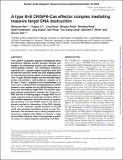Files in this item
A type III-B CRISPR–Cas effector complex mediating massive target DNA destruction
Item metadata
| dc.contributor.author | Han, Wenyuan | |
| dc.contributor.author | Li, Yingjun | |
| dc.contributor.author | Deng, Ling | |
| dc.contributor.author | Feng, Mingxia | |
| dc.contributor.author | Peng, Wenfang | |
| dc.contributor.author | Hallstrøm, Søren | |
| dc.contributor.author | Zhang, Jing | |
| dc.contributor.author | Peng, Nan | |
| dc.contributor.author | Liang, Yun Xiang | |
| dc.contributor.author | White, Malcolm Frederick | |
| dc.contributor.author | She, Qunxin | |
| dc.date.accessioned | 2016-12-20T17:30:10Z | |
| dc.date.available | 2016-12-20T17:30:10Z | |
| dc.date.issued | 2017-02-28 | |
| dc.identifier | 248135050 | |
| dc.identifier | 84c3e438-d1fd-4d81-a4b6-62c4c7577f6b | |
| dc.identifier | 000396055400042 | |
| dc.identifier | 000396055400042 | |
| dc.identifier | 85014463036 | |
| dc.identifier.citation | Han , W , Li , Y , Deng , L , Feng , M , Peng , W , Hallstrøm , S , Zhang , J , Peng , N , Liang , Y X , White , M F & She , Q 2017 , ' A type III-B CRISPR–Cas effector complex mediating massive target DNA destruction ' , Nucleic Acids Research , vol. 45 , no. 4 , pp. 1983-1993 . https://doi.org/10.1093/nar/gkw1274 | en |
| dc.identifier.issn | 0305-1048 | |
| dc.identifier.other | ORCID: /0000-0003-1543-9342/work/47136105 | |
| dc.identifier.uri | https://hdl.handle.net/10023/9994 | |
| dc.description | Funding: Biotechnology and Biological Sciences Research Council [BB/M000400/1 to MFW]. | en |
| dc.description.abstract | The CRISPR (clustered regularly interspaced short palindromic repeats) system protects archaea and bacteria by eliminating nucleic acid invaders in a crRNA-guided manner. The Sulfolobus islandicus type III-B effector Cmr-α complex targets invading nucleic acid at both RNA and DNA levels and DNA targeting relies on the directional transcription of the protospacer in vivo. To gain further insight into the involved mechanism, we purified a native effector complex of III-B Cmr-α from S. islandicus and characterized it in vitro. Cmr-α cleaved RNAs complementary to crRNA present in the complex and its ssDNA destruction activity was activated by target RNA. ssDNA cleavage required mismatches between the 5’-tag of crRNA and the 3’-flanking region of target RNA. An invader plasmid assay showed that mutation either in the HD domain (a quadruple mutation) or in the GGDD motif of theCmr-2α protein resulted in attenuation of the DNA interference in vivo. However, double mutation of the HD motif only abolished the DNase activity in vitro. Furthermore, the activated Cmr-α binary complex functioned as a highly active DNase to destroy a large excess of substrate, which could provide a powerful means to rapidly degrade replicating viral DNA. | |
| dc.format.extent | 11 | |
| dc.format.extent | 4054961 | |
| dc.language.iso | eng | |
| dc.relation.ispartof | Nucleic Acids Research | en |
| dc.subject | CRISPR-Cas | en |
| dc.subject | RNA-activated DNA cleavage | en |
| dc.subject | Dual nucleic acids interference | en |
| dc.subject | Cas10 | en |
| dc.subject | Sulfolobus islandicus | en |
| dc.subject | QH301 Biology | en |
| dc.subject | QH426 Genetics | en |
| dc.subject | T Technology | en |
| dc.subject | NDAS | en |
| dc.subject.lcc | QH301 | en |
| dc.subject.lcc | QH426 | en |
| dc.subject.lcc | T | en |
| dc.title | A type III-B CRISPR–Cas effector complex mediating massive target DNA destruction | en |
| dc.type | Journal article | en |
| dc.contributor.sponsor | BBSRC | en |
| dc.contributor.institution | University of St Andrews. School of Biology | en |
| dc.contributor.institution | University of St Andrews. Biomedical Sciences Research Complex | en |
| dc.identifier.doi | 10.1093/nar/gkw1274 | |
| dc.description.status | Peer reviewed | en |
| dc.identifier.grantnumber | BB/M000400/1 | en |
This item appears in the following Collection(s)
Items in the St Andrews Research Repository are protected by copyright, with all rights reserved, unless otherwise indicated.

